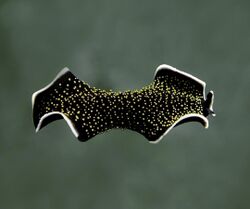Biology:Thysanozoon nigropapillosum
| Thysanozoon nigropapillosum | |
|---|---|

| |
| Thysanozoon nigropapillosum swimming in Manta Ray Bay, Yap | |
| Scientific classification | |
| Domain: | Eukaryota |
| Kingdom: | Animalia |
| Phylum: | Platyhelminthes |
| Order: | Polycladida |
| Family: | Pseudocerotidae |
| Genus: | Thysanozoon |
| Species: | T. nigropapillosum
|
| Binomial name | |
| Thysanozoon nigropapillosum (Hyman, 1959)[1]
| |
| Synonyms | |
| |
Thysanozoon nigropapillosum is a species of polyclad flatworms belonging to the family Pseudocerotidae. Some common names include gold-speckled flatworm, marine flatworm, yellow papillae flatworm, yellow-spotted flatworm, and yellow-spotted polyclad flatworm.
Description
Thysanozoon nigropapillosum has a long body and broad shape. They grow up to 3 in (76 mm).[2] The dorsal surface is deep black and covered with numerous yellow-tipped papillae varying in size. The ventral surface is dark brown. The outer margin of the body is slightly wavy and bordered in opaque white. They have small, ear-like pseudotentacles in the middle of the anterior end.[3] They swim by propelling themselves through the water with a rhythmic undulating motion of the body.[2]
Distribution
This species is widespread in the tropical Indo-Pacific.[4]
Biology
Thysanozoon nigropapillosum is quite common along the external reef in the shallow sub-tidal zone. It can swim by undulating and rhythmically contracting the body margins. It feeds on tunicates, using its mouth and large pharynx to engulf Didemnum spp., and later regurgitates food pellets containing the calcareous spicules present in their tunics. Polyclad flatworms are hermaphrodites, with each one of a pair of flatworms trying to inseminate the other. Transfer of sperm may be by hypodermic insemination, but this is made difficult in this species by the presence of the papillae, and dermal impregnation often occurs. This involves sperm entering the body directly after being placed in the marginal region of the skin. Such dermal insemination is facilitated by the fact that the flatworm has two penises which are strengthened by the presence of rhabdites, and these can grip the margin of the partner and keep hold, even while the recipient is swimming.[5]
References
- ↑ Hyman, Libbie H. (1959). "A further study of micronesian Polyclad flatworms.". Proceedings of the United States National Museum 108: 543–597. https://www.biodiversitylibrary.org/page/7604059#page/625/mode/1up. Retrieved 12 April 2020.
- ↑ 2.0 2.1 Robert Dinwiddie (2014). Ocean: The Definitive Visual Guide. Dorling Kindersley. pp. 272. ISBN 9781465436207. https://books.google.com/books?id=McT-AwAAQBAJ&dq=size+of+Thysanozoon+nigropapillosum&pg=PA272.
- ↑ Wei-Ban Jie; Shih-Chieh Kuo; Hin-Kiu Mok (December 2014). "Re-description of Thysanozoon nigropapillosum (Polycladia: Pseudocerotidae) From The South China Sea, With Observations on a Novel Pre-Copulatory Structure, Sexual Behavior and Diet". Raffles Bulletin of Zoology 62: 764–770. https://lkcnhm.nus.edu.sg/nus/images/data/raffles_bulletin_of_zoology/zoology_volume_62/62rbz764-770.pdf.
- ↑ Robert Dinwiddie (2014). Ocean: The Definitive Visual Guide. DK Publishing. p. 272. ISBN 978-1-4654-3620-7. https://books.google.com/books?id=McT-AwAAQBAJ&pg=PA272. Retrieved 2018-07-12.
- ↑ Jie, Wei-Ban; Kuo, Shih-Chieh; Mok, Hin-Kiu (2014). "Re-description of Thysanozoon nigropapillosum (Polycladida: Pseudocerotidae) from the South China Sea, with observations on a novel pre-copulatory structure, sexual behaviour and diet". The Raffles Bulletin of Zoology 62: 764–770. https://lkcnhm.nus.edu.sg/app/uploads/2017/06/62rbz764-770.pdf.
External links
- World Database of Marine Species
- Seaslugs
- Worms
- Zipcodezoo
- Gwannon
- Photos of Thysanozoon nigropapillosum on Sealife Collection
Wikidata ☰ Q7799832 entry
 |





